Ki-44 Shoki in Nationalist Chinese Markings
By Brad Gaff
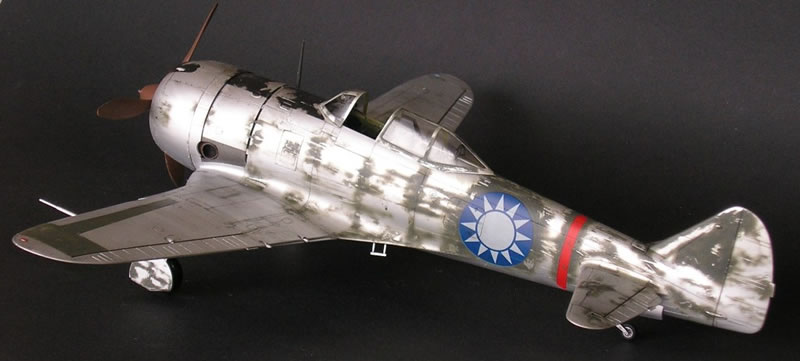
History
Designed to be a pure interceptor by Nakajima, the Ki-44 would first fly in August 1940 with combat trials starting in September of 1941. Despite being superior in climb rate, having a heavy armament and able to match allied fighters in a dive, it was not well liked by pilots due to its poor visibility, high landing speed and not being as nimble as the Ki-43 Oscar. 1,225 machines were built and proved to be a capable fighter with an experienced pilot in the cockpit. It would remain in service until the end of the war with Japan, but that would not be the end of its career.
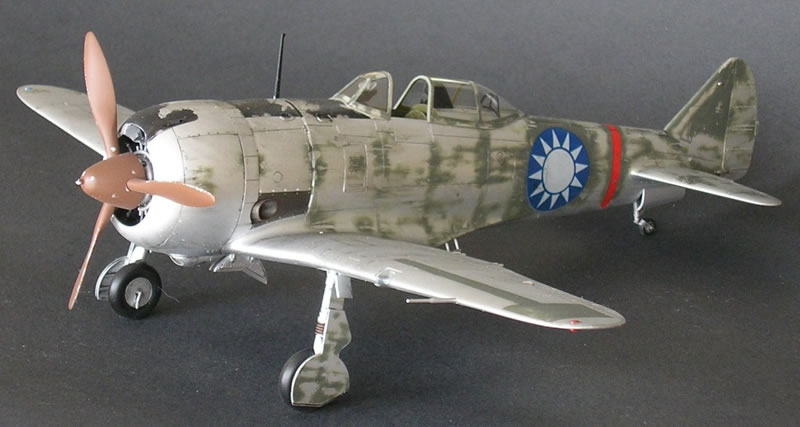
The Chinese Civil War, which had been raging since 1927 was put on hold when Japan invaded in 1936, but broke out again after the Japanese surrender in 1945. Aircraft which had not been destroyed by the Japanese were quickly snapped up by both the Nationalists lead Chiang Kai-shek and the Communists, under Mao Zedong. Along with aircraft, Japanese pilots who were stranded in China turned mercenary, fighting with and training pilots from both sides. Japanese aircraft would be retired fairly quickly from front line service when surplus equipment from the USA became available to the Nationalists. Japanese aircraft in Red Army service were supported a little longer, due to spares being supplied by the Russians from machines captured in Manchuria. This aircraft, one of 4 known to be in service with the 6th Fighter Bomber Group in Nationalist Chinese Air Force, is thought to be an ex 9th Sentai machine.
The Kit
Hasegawa’s newer 1/32 offerings are superb kits to build with excellent detail straight out of the box, so it would be rather boring of me to give you a complete run down of gluing the kit together. If you follow the instructions, you won’t have much of a problem. That said I will mention that the upper wings don’t quite line up with the lower wing section and it is worth filing down one side of the locating pins to reduce filling and sanding. Care should also be taken to test fit the landing light cover as I had a bit of a fight to get mine to fit and it still didn’t quite do what I wanted it to. Look out for some annoying injector pin marks on the inside of the landing gear doors too.

Finish
Looking at pictures of this aircraft, it seemed as though someone had tried to paint strip it and I wondered how I would produce this scraped effect. Initially, a base coat of Humbrol Metal Cote 27002 was applied and sealed with gloss. I had experimented with applying a liquid masking solution over the base coat then spraying the camouflage colour. However, this produces more of a hard edged, ripped effect and wasn’t quite what I was after.
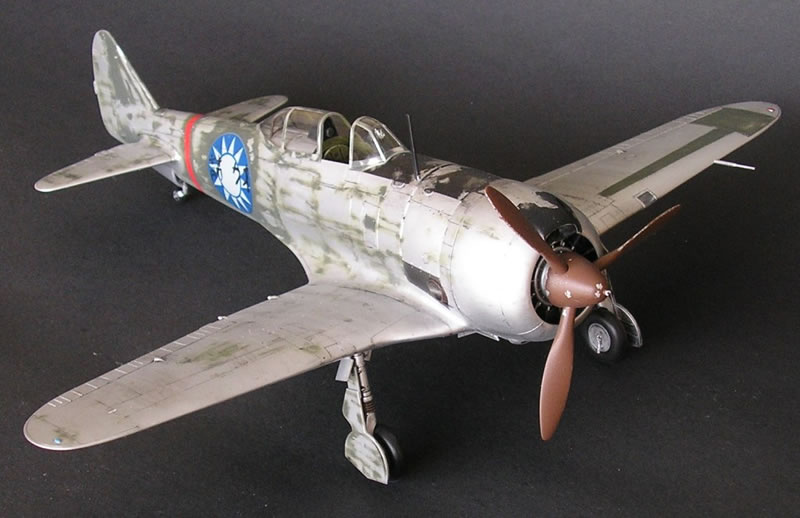
I decided that I would spray Gunze IJA Green over the top, but thin with water instead of lacquer thinner figuring it would make it easier to sand or rub back with a water soaked cotton bud. I sprayed the green roughly where I wanted paint to remain on the airframe and then set to work. It took quite a while to work back some of the paint as Gunze dries pretty quickly when you have the heater on in the house! Trying to soften up the paint a little, I found that Tamiya thinner on a cotton bud will strip Gunze paint pretty effectively.
I decided for the rest of the aircraft, I would have the wet cotton bud with me while spraying and strip the paint back almost as soon as I had put it on the surface. I would paint a small section, damage it with the cotton bud then slowly work my way down the kit. This was much easier. I used the Tamiya thinner to take some bigger chunks out of the paint when it has dried for about 10 minutes. You can also use brushes and tooth picks to scratch the paint too. When dry, another gloss coat was added in preparation for decals and a wash. This was also done for the anti glare panel, which I painted after I finished with the green camouflage.
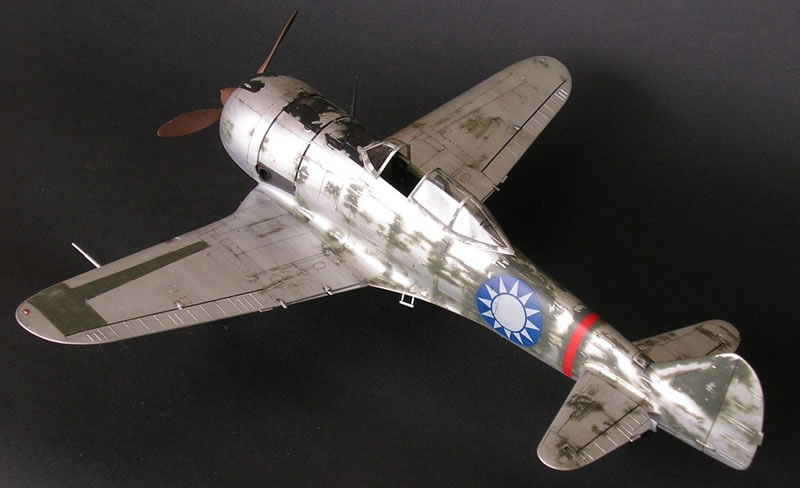
The Nationalist Chinese markings came from a 1/48 Blue Rider decal sheet. The two decals I used initially had the blue run in them, causing the white to be stained but luckily I had 2 spares which seem to be OK, so I’m not quite sure what happened to those. The red band was the decal from the kit. The panel line wash was just black chalk pastel, ground up and mixed with water and dishwashing liquid. I streak it back in the direction of the airflow with a damp cloth when it has dried on the surface (usually about 10 minutes). Once I was happy with the effect, I painted the Chinese writing on the side of the aircraft freehand and sealed it all with Humbrol matt before all the odd and ends were attached (canopy, gun sight etc).
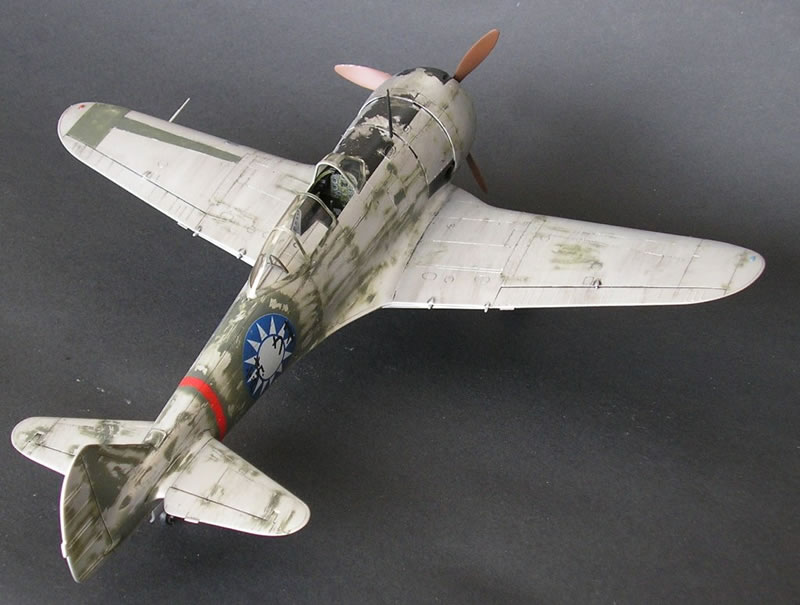
Conclusion
I did take a little artistic licence with the camouflage, as I’ve added some replaced panels on the wing and left off the wing roundels (upper and lower) as I couldn’t see them in any of the pictures. As mentioned, this kit is very nice to build and would be suitable for all modellers. Now, I might need another one of these to build a Red Army of China example...
© 2012 Brad Gaff
This article was published on Friday, August 17 2012; Last modified on Tuesday, January 24 2017
